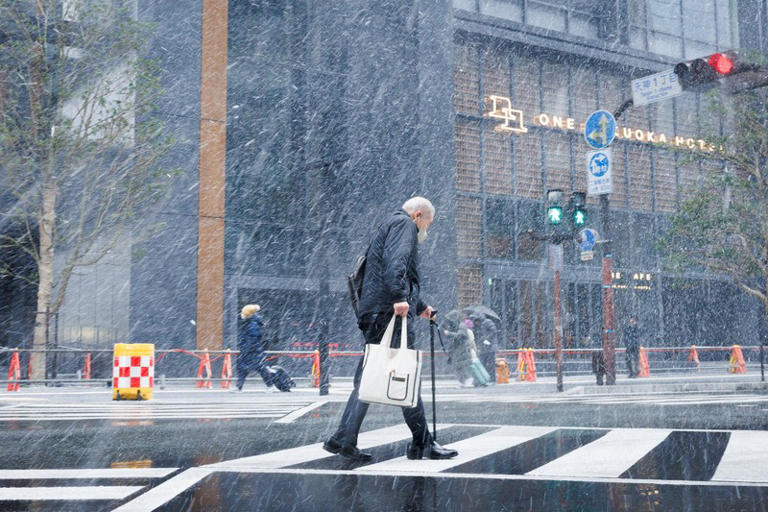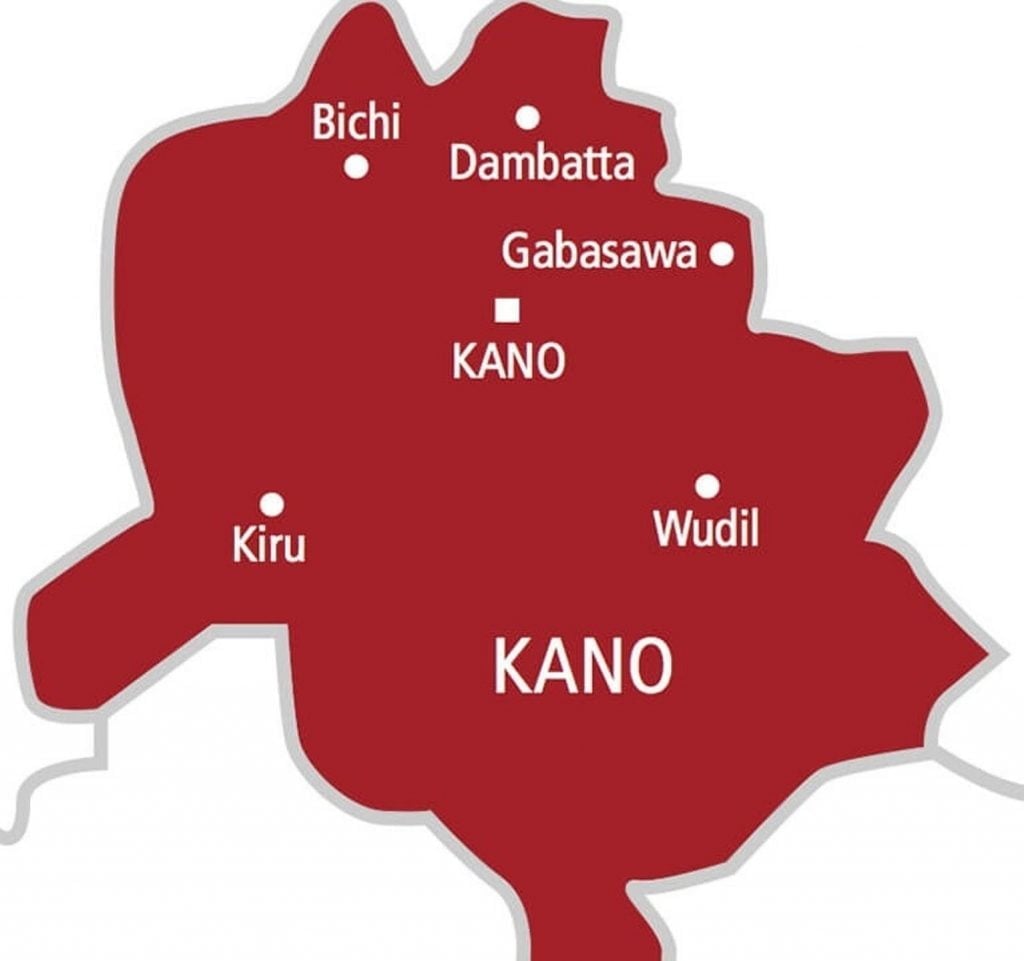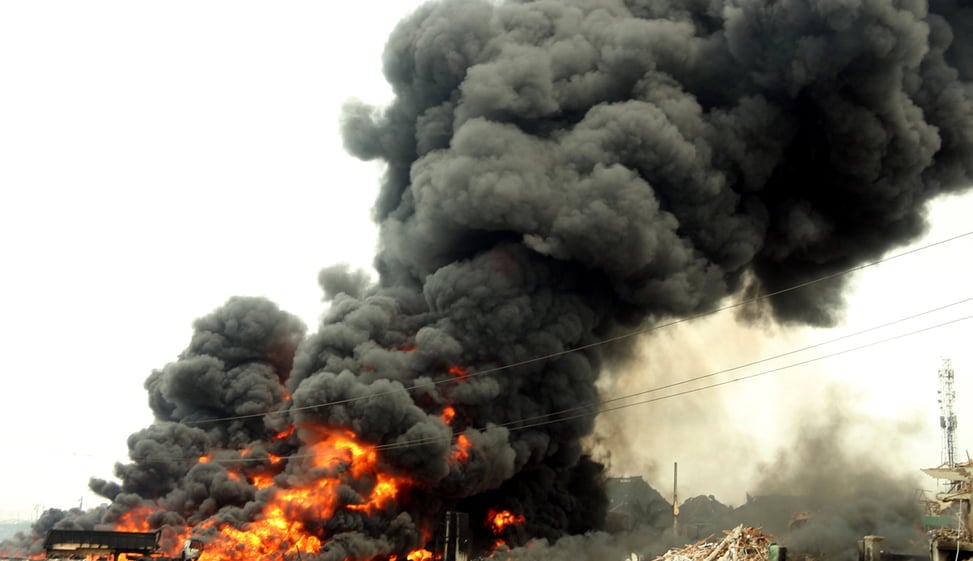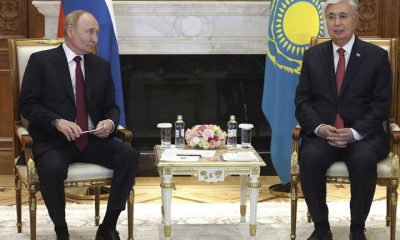Trending
Heavy snow strikes southwest Japan as weather agency issues snowstorm warnings
Published
3 months agoon
By
Ekwutos Blog
FUKUOKA — The Japan Meteorological Agency issued snowstorm warnings for ocean areas off the Fukuoka region that includes this southwest Japan city and Hibikinada Sea off Kitakyushu on the morning of Jan. 9, as a cold air mass sweeping over the country brought snow to the northern Kyushu region.
The Fukuoka District Meteorological Observatory warned of strong winds with snow and called for people to be on the lookout for traffic disruptions due to accumulated snow and icy roads.
Starting in the morning, heavy snow fell intermittently in central Fukuoka and people, some with umbrellas, were seen hurrying through the city’s bustling Tenjin district as snow swirled around them.
According to the local meteorological observatory, a cold air mass with temperatures dropping below minus 12 degrees Celsius — the most severe this season — is expected to flow into the northern Kyushu region at an altitude of approximately 1,500 meters through Jan. 10, intensifying the winter pressure pattern. Over the 24-hour period up to 6 a.m. on Jan. 10, the region, excluding Yamaguchi Prefecture, is expected to receive up to 10 centimeters of accumulated snow in mountainous regions and 5 cm on plains.
(Japanese original by Azusa Yamazaki, Kyushu News Department)
You may like


Olumba Olumba Obu Honored: Actors Guild of Nigeria Awards Spiritual Leader “King of Nollywood”


If I had remained as governor of Anambra State, I would have done one single term of four years and leave—Chris Ngige


How Olamide saved me from being a lamp seller – Fireboy DML


Court Orders Suspended DCP Abba Kyari to Open Defence in Cocaine Trafficking Case


2027: PDP Governors, Senators Reject Atiku’s Coalition


I took some guys from Lagos to Abuja for Lab0ur w0rk, they are not underage ooo Atanda, these guys ran away from site and as am speaking to you I don’t know their whereabouts, their ph0ne number is not reachable Their wives and family are on my neck In fact, they have rep0rted me to the Police already and i don’t know the extent they want to drag me this matter to I don’t know when they will show up If i submit myself to the P0lice now, won’t they detain me till they show up How long will i be remanded in pris0n before coming out just because two foolish adult i gave w0rk decides to run away?
Trending
Estranged Wife Of Lagos Clearing Agent Arrested For Defiling 10-Year-Old Girl Says Suspect Inflicted Injuries On Her, Abandoned Four Children Since 2016
Published
1 hour agoon
April 12, 2025By
Ekwutos Blog
Narrating her ordeal to newsmen, the woman, Modupe, revealed that the abuse began after she discovered her husband had impregnated a young woman she identified as Sade Falaye, who was close to the family.
The estranged wife of a 54-year-old clearing agent and Lagos resident, Oluwaseyi Faturoti, who was arrested in March for allegedly defiling a 10-year-old girl, has recounted years of alleged abuse and abandonment she endured while married to the suspect.
Ekwutosblog in March reported that Faturoti, a clearing agent from Tincan Island, Apapa, allegedly sexually assaulted a 10-year-old girl when the girl’s mother, his former lover, left the child in his care.
The victim’s mother had discovered blood on the floor the next day and questioned her daughter. Initially, the daughter declined to speak but later revealed the horrific truth.
Narrating her ordeal to newsmen, the woman, Modupe, revealed that the abuse began after she discovered her husband had impregnated a young woman she identified as Sade Falaye, who was close to the family.
She said, “I have a lot of evidence including my body where he beat me. I think the shame of the girl, Sade Falaye, he impregnated made him run away from the house. Because the girl was like my girl.”
She said she unknowingly carried and cared for the child fathered by her husband with Sade, an auxiliary nurse who used to treat the family during medical emergencies.
The discovery led to a violent fallout between the couple.
“The girl gave birth to the baby and I didn’t know the baby belonged to him (her husband). I used to carry the baby in my car and bring the baby home, not knowing that the baby belongs to him. It was after seven months the girl gave birth that I found out that the baby belongs to my husband.
“When I found out, I challenged him and we fought, since then, he started beating me every day.
“He then said that I must pack out from his house. I told him I would never pack out because I did all the Labour when we built the house, and I have four children for him, hence, he can never send me out of the house,” she said.
Despite the intervention of family members, she said her husband insisted on her eviction.
“My mother and his mother came from the village, despite all the cheating he cheated on me, my mother begged him to allow me to take care of my four children so that I would not become a single mother but he refused and insisted that I must pack out.”
She added that her refusal to vacate their home led to her husband leaving instead.
“I told him that he could pack out of the house if he wanted to leave. Because he said he wanted to bring in another woman, and that he can’t stay in the same house with me, I told him to take the woman to another house, not our three-bedroom house with my four children,” she said.
Speaking further, she lamented years of repeated infidelity by her ex-husband.
“A lot has been happening about his womanising behaviour. We have been fighting. At a point my mother advised me to let him do whatever he wanted. I let him be. I’m still in the house. He is the one that packed out.
“The girl he impregnated is an auxiliary nurse who used to treat us whenever my children, me or my husband were sick. She was not living with us but we worship in the same church.”
According to her, her ex-husband has not contributed in any way to the welfare of their children since his departure in 2016.
“Since 2016, he left me and the four children without taking responsibility for any one of them till now. I have suffered so much in his hands.
“Currently, I have three children in the university but he blocked all of my children’s numbers. I’m the only one sponsoring them without him contributing a penny.”
She lamented that her financial struggles had been severe.
She also revealed that despite impregnating Sade, who was 29 at the time, her husband never married her and has since been involved with and separated from multiple other women.
Concluding her account with a painful summary of her family’s current plight, she said, “My husband is a violent man.
“I have scars all over my body where he beat me. All my children are hungry in school. Since last week I have been looking for N2000 to send to my daughter in school.”
Trending
Kano girls married off from orphanage home abandoned by husbands, abused, seek alms
Published
13 hours agoon
April 12, 2025By
Ekwutos Blog
The Nassarawa orphanage home in Kano serves as a sanctuary for abandoned children, some of whom discovered on roadsides, orphaned by the death of their parents, or left behind after accidents.
For many years, the orphanage has been supported by the Kano State Government, which provides for their feeding, clothing, and education until they reach adulthood.
The boys often find employment in government agencies or start their own businesses, while the girls are typically married off to interested suitors.
Hundreds of girls have been married off since the orphanage started, but some women who spoke to Ekwutosblog voiced their frustrations, revealing they were abandoned after their husbands divorced them. They also face abuse and mistreatment with little recourse for reporting their struggles.
Hadiza Muhammad, 40, and Halima Muhammad, 45, are two such women who have endured domestic abuse for more than two decades of marriage, having children along the way.
“I grew up in the Nassarawa orphanage home. I was told I was found along the Kaduna road after a car crash, and I was the only survivor. I grew up there until I was old enough to marry,” Hadiza Muhammad shared with Ekwutosblog about her past and current struggles.
“When we grew older, they pressured us to get married and leave the orphanage because new children kept arriving and they needed the space. We were told we had to go so things could balance out.”
“Before then, a woman took me in and sponsored most of my schooling, but we later had a fall-out, and she returned me to the orphanage when I was 17. I was just beginning to become a young woman.”
Hadiza eventually married a man from the Republic of Niger. “After almost 15 years of suffering, hardship, and abuse, we had two children. Then, he divorced me and threw me out with the kids. Now, he doesn’t even sleep at home, living like a street person. I’m helpless. I don’t know what to do. I returned to the orphanage home where I grew up, but they told me there was no space for us since we are now mothers,” Hadiza added sadly.
Halima Muhammad, who grew up alongside Hadiza, has faced a similar fate. Her husband also divorced her, leaving her with five children.
“Now, our landlord wants to evict us because we can’t pay rent. I have no one to fight for my rights against my ex-husband. I’m also battling diabetes, high blood pressure, and asthma due to stress and constant worry,” she explained.
Both women have called on the Kano State Government to establish a system that supports women in similar circumstances, as many others continue to endure abuse and mistreatment, some still trapped in abusive marriages.
Comrade Hafiz Sanusi Sanka, the Kano State Chairman of the International Human Rights Commission, also spoke with Ekwutosblog . He confirmed that they often receive similar complaints and are in communication with relevant stakeholders to find solutions. He expressed optimism about the ongoing efforts by the Kano State Government.
“We visited the orphanage regarding this matter and had in-depth discussions. They seem to be taking meaningful steps. Personally, I’m satisfied and confident that the issue will soon be resolved,” he stated.
“There is a house designated for women in these situations, but it is too small. As we speak, the Governor has ordered the construction of 20 new houses specifically for them—whether their marriages end or their husbands pass away,” he added.
Sanka also mentioned that the government is making efforts to provide employment for those who grew up in the orphanage home. “The head of the home told me that just last week, the Governor offered jobs to 22 orphans in the house—both men and women—in government positions,” he noted.
The government’s actions are seen as a positive step towards resolving the issue. “We must continue pushing for these initiatives to be carried out to support these women,” Sanka said.
Ekwutosblog reached out to the authorities at the Nassarawa orphanage home for further comment. However, the head of the home, Hajiya Maimunatu, stated that she was not authorized to speak to the press.
But she confirmed the statement of Kano IHRC Chairman, Comrade Sanka.
Every year, dozens of children are abandoned or found across Kano State and its surrounding areas.
By law, the care of these children falls under the responsibility of government-established institutions, ensuring they are given the chance to grow up and live a fulfilling life.
Trending
Panic in Lagos as explosion rocks building
Published
14 hours agoon
April 12, 2025By
Ekwutos Blog
Panic erupted on Friday evening around the Ikeja Under Bridge area following a loud explosion from a building beside the Cash & Carry store on Kodesho Road, inward Awolowo Way.
The blast, which occurred around 6:30 pm, shook the surrounding environment and sent residents and passersby fleeing in fear.
According to eyewitnesses, the explosion was caused by a solar inverter that suddenly blew up.
“The explosion was caused by an inverter that blew up. The Lagos Fire and Rescue Service is already on the scene.
“There’s heavy traffic in the area, and people were seen running in panic,” said Rabiu Abass, speaking to Vanguard.
Emergency responders, including officials of the Lagos State Fire and Rescue Service, quickly arrived at the scene and began efforts to contain the fire.
Director of the Fire and Rescue Service, Mrs. Margaret Adeseye, confirmed the incident and assured the public that the situation was under control.
“There is no cause for alarm. The situation is under control,” she said.
However, as of 8:30 p.m., officials were still actively working to extinguish the fire, which affected a building in the area.
The Lagos State Traffic Management Authority (LASTMA) also confirmed the incident in a post on X, stating that officers had rerouted traffic from the General Hospital, underneath the bridge, through the Oba Akran Bridge to ensure the safety of motorists.
A video from the scene showed a car with shattered glass on the right-hand side.
In the video, a woman could be heard thanking God for sparing her life. “I thought it injured me. Father, I thank you,” she said as she circled her damaged vehicle in shock.
Another eyewitness, an X user identified as The KVNG (@Teclef), shared his close encounter: “I was in the middle of the road, about to cross to the front of the explosion.”

Olumba Olumba Obu Honored: Actors Guild of Nigeria Awards Spiritual Leader “King of Nollywood”

If I had remained as governor of Anambra State, I would have done one single term of four years and leave—Chris Ngige

How Olamide saved me from being a lamp seller – Fireboy DML
Trending

 Trending6 months ago
Trending6 months agoNYA demands release of ‘abducted’ Imo chairman, preaches good governance
- Business6 months ago
US court acquits Air Peace boss, slams Mayfield $4000 fine

 Politics6 months ago
Politics6 months agoMexico’s new president causes concern just weeks before the US elections
- Entertainment6 months ago
Bobrisky transferred from Immigration to FCID, spends night behind bars
- Entertainment6 months ago
Bobrisky falls ill in police custody, rushed to hospital

 Politics6 months ago
Politics6 months agoRussia bans imports of agro-products from Kazakhstan after refusal to join BRICS

 Politics6 months ago
Politics6 months agoPutin invites 20 world leaders
- Politics1 year ago
Nigerian Senate passes Bill seeking the establishment of the South East Development Commission.

